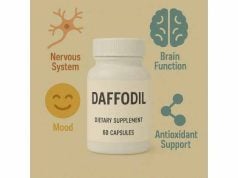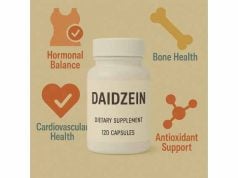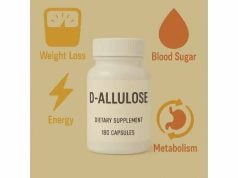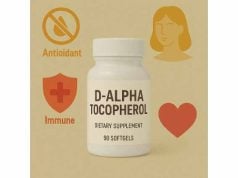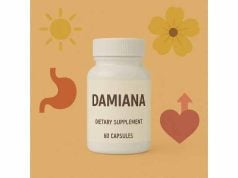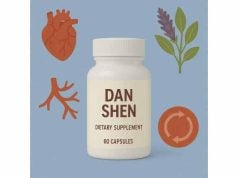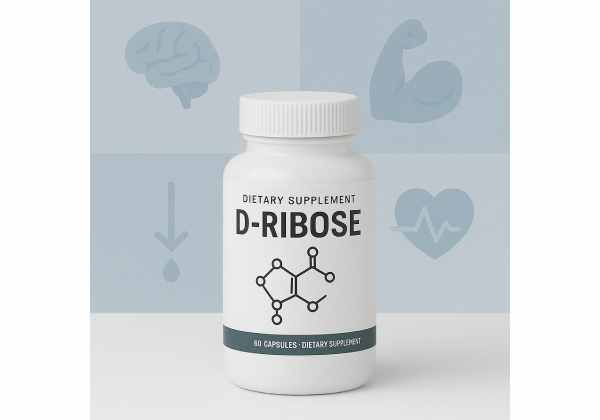
D-ribose (often shortened to “ribose”) is a simple sugar your body already makes to build ATP—the universal energy currency in cells. When energy demand outpaces supply, like during intense exercise or in conditions that strain the heart or muscles, ribose can become a bottleneck. Supplemental D-ribose aims to ease that bottleneck by supplying the raw material cells use to rebuild ATP and other nucleotides. Early research in heart failure has shown symptom improvements, and small studies suggest it may help with fatigue in select situations. However, D-ribose is not a stimulant, and it can transiently lower blood glucose—an important safety point. In this guide, you will learn how D-ribose works, who may benefit, how to dose it responsibly, and which side effects to watch for based on current clinical evidence.
Quick D-Ribose Highlights
- May support heart failure symptoms and ejection fraction when used under medical care.
- Can temporarily lower blood glucose; take with food and avoid if you have uncontrolled diabetes.
- Typical use: 2.5–5 g once or twice daily; clinical protocols sometimes use 15 g per day.
- Avoid in pregnancy, breastfeeding, in children, and when using insulin or sulfonylureas unless advised by a clinician.
Table of Contents
- What is D-ribose and how it works
- Top D-ribose benefits: what to expect
- How to use D-ribose day to day
- How much D-ribose per day?
- Who should avoid D-ribose and why
- What the research says today
What is D-ribose and how it works
D-ribose is a five-carbon sugar (a pentose) that cells use to construct ribonucleotides—the building blocks of ATP, RNA, and key cofactors. Inside cells, ribose is phosphorylated to ribose-5-phosphate and channeled into the pentose phosphate pathway (PPP). From there, it feeds two critical needs: (1) making phosphoribosyl pyrophosphate (PRPP), which is required to build adenine and guanine nucleotides; and (2) providing PPP intermediates that reconnect to central energy metabolism. In short, D-ribose supplies carbons that help replenish the adenine nucleotide pool, which can be depleted during ischemia, heavy exertion, or chronic energy stress.
Why would supplementing D-ribose help? In stressed tissues like the heart or skeletal muscle, rebuilding ATP can be rate-limited not just by oxygen or mitochondrial function but by the availability of nucleotide precursors. Exogenous ribose bypasses some slower steps and can accelerate the restoration of ATP when it is low. That is the mechanistic rationale behind studies in heart failure and post-exercise fatigue. Importantly, D-ribose does not “push” the body to make energy it does not need; it simply offers substrate when the demand is high and precursors are scarce. This is why D-ribose is not a stimulant: you will not feel the immediate “kick” of caffeine. Any benefits tend to be subtler—improved tolerance for activity, less heaviness in the legs after exertion, or better quality-of-life scores in symptomatic patients—when and if D-ribose is the limiting factor.
Because ribose is a simple sugar, the body can absorb it quickly. After ingestion, blood levels rise and then fall within a couple of hours as tissues take it up. A practical implication is timing: smaller, food-spaced doses can reduce the chance of transient dips in blood glucose and gastrointestinal discomfort, while still supplying steady substrate to tissues. Another implication is expectations: ribose’s effects depend on context. In well-trained athletes with adequate substrate and robust mitochondria, D-ribose rarely moves the performance needle. In specific clinical settings—most notably heart failure with preserved ejection fraction (HFpEF)—research has documented improvements in patient-reported symptoms and cardiac metrics when ribose is used within a broader treatment plan.
Finally, a nuance on metabolism: while D-ribose supports ATP repletion, high concentrations can participate in non-enzymatic glycation (the same chemical process that underlies advanced glycation end products). In vitro and observational work has linked elevated ribose to increased protein glycation. That does not make dietary doses inherently harmful, but it explains why careful dosing, food co-ingestion, and appropriate patient selection matter.
Top D-ribose benefits: what to expect
Heart failure symptom support (under supervision). The best clinical signal for D-ribose comes from heart failure, especially HFpEF. In a randomized, double-blind, placebo-controlled phase 2 trial of adults with HFpEF, 12 weeks of supplementation (15 g per day) alongside usual care improved health status on the Kansas City Cardiomyopathy Questionnaire and raised left ventricular ejection fraction by roughly seven to eight percentage points on average. Natriuretic peptide levels fell, while the six-minute walk test did not change significantly. For patients who remain symptomatic despite guideline-directed therapy, clinicians sometimes consider D-ribose as an adjunct to target cellular bioenergetics. The take-home: ribose is not a replacement for standard care, but it may help some patients feel and function better when integrated thoughtfully.
Exercise recovery and perceived fatigue. In otherwise healthy people, small studies and practical reports suggest D-ribose may lessen muscle stiffness and soreness after unaccustomed exercise and speed the return of energy after very demanding sessions. Mechanistically this is plausible: ribose contributes to faster nucleotide repletion in muscle recovering from intense work. That said, evidence for improved peak performance or time-trial outcomes in trained athletes is weak. Expect recovery or “feel” improvements rather than performance breakthroughs, and only when training is severe enough to deplete nucleotide pools.
Fibromyalgia and chronic fatigue symptoms (low-quality evidence). Open-label and pilot work has reported reductions in pain and fatigue scores with D-ribose over several weeks in people with fibromyalgia or chronic fatigue syndromes. These studies lacked placebo control or had small samples, so they are hypothesis-generating rather than definitive. If used at all in this context, it should be as a time-limited, monitored trial with clear stop rules if no benefit emerges.
Targeted rare disease applications. Emerging research has explored ribose in disorders of glycosylation pathways. A recent case study in dystroglycanopathy used 9–18 g per day for six months; supplemental ribose was well tolerated and raised intracellular CDP-ribitol (a related metabolite), with subjective improvements and lowered creatine kinase. This is a highly specialized use that should remain within research or specialist care.
What D-ribose is unlikely to do. It is not a stimulant, and it does not reliably boost power output or speed in trained athletes. It does not treat the root causes of most chronic fatigue states. And despite being a sugar, it does not supply meaningful dietary energy at typical supplemental doses.
How to frame expectations. The most realistic outcomes are modest: a patient with HFpEF experiences better quality-of-life scores; a recreational athlete reports less next-day heaviness after a grueling workout; a person with chronic fatigue notices a small uptick in daily stamina. Benefits, when they occur, usually appear within two to four weeks of consistent, divided dosing and are contingent on the underlying physiology being ribose-limited.
How to use D-ribose day to day
Choose a simple powder. Most products provide pure D-ribose powder. Look for third-party testing (for example, USP, NSF Certified for Sport, or Informed Choice) and avoid blends that add stimulants or large amounts of other sugars. Powders dissolve easily in water or can be mixed into yogurt or a smoothie.
Time with meals to reduce glucose dips. D-ribose can lower blood glucose transiently, particularly when taken fasting and at higher single doses (for example, 10 g at once). To minimize that, take smaller amounts (2.5–5 g) with or immediately after meals or snacks, and split your total daily amount into two to three servings. If you train hard in the afternoon, one serving with lunch and another with a post-workout snack works well for many people.
Start low and adjust. A practical starting point for generally healthy adults is 2.5 g once daily with food for two to three days, then 2.5 g twice daily for a week. If well tolerated and you have a use case that justifies it (for example, repeated exhaustive workouts), consider 5 g twice daily. Increase only if you have a clear objective and good tolerance. If you notice shakiness, lightheadedness, or unusual fatigue, stop and take in a mixed snack (carbohydrate plus protein) and discuss with a clinician.
Combine thoughtfully. Some cardiac studies paired D-ribose with ubiquinol (the reduced form of coenzyme Q10). There is no requirement to combine them, but if your cardiology team already uses ubiquinol, a combination protocol may reflect their practice. Avoid stacking D-ribose with other agents that lower blood glucose (for example, berberine) unless supervised.
Hydration and electrolytes still matter. Ribose is not a hydration agent. If you are using it around exercise, keep your usual hydration and electrolyte strategy in place; consider taking ribose with a small carbohydrate-containing snack to buffer glucose dips.
Set stop rules. If you are trialing D-ribose for recovery or fatigue, set an evaluation window (for example, two to four weeks). If you perceive no meaningful change in daily energy, sleep quality, training recovery, or symptom scores, it is reasonable to stop. For medical uses, follow your clinician’s monitoring plan.
Storage and stability. Keep the container tightly closed, dry, and away from heat. Clumping can occur in humid environments; breaking up clumps does not affect function as long as the powder is clean and within the labeled shelf life.
How much D-ribose per day?
Everyday use (general wellness or recovery). For most healthy adults, 2.5–5 g once or twice daily with food is a conservative range. Many people stay at 5–10 g per day in divided doses when using D-ribose for heavy training blocks or short trials for fatigue. Single doses above 10 g increase the chance of gastrointestinal upset and transient hypoglycemia, especially when fasting.
Heart failure protocols (clinician-directed). In a randomized, double-blind HFpEF trial, participants used 15 g per day split across the day for 12 weeks as part of a supervised plan. Older crossover work in congestive heart failure similarly used divided dosing over several weeks and found improvements in diastolic function and quality of life. If you have heart failure, do not self-start supplements; dosing and monitoring should follow your cardiologist’s guidance.
Rare disease or experimental contexts. In dystroglycanopathy, a single-patient case study escalated ribose from 9 g to 18 g per day (three divided doses) for six months with good tolerance and biochemical responses. Such use is investigational and should only occur within specialist care.
Safety thresholds and official opinions. The European Food Safety Authority evaluated D-ribose as a novel food and concluded it is safe for the general population at intake levels up to 36 mg per kilogram of body weight per day (about 2.5 g per day for a 70-kg adult). They considered 5 g per day the no-observed-adverse-effect level for transient hypoglycemia in adults. Intakes above these levels have been used in clinical studies under supervision, but if you are not in a monitored protocol, it is prudent to remain at or below the conservative general-population threshold and to avoid high single doses.
Practical dosing templates.
- Recovery focus: 2.5 g with lunch and 2.5 g with your post-exercise snack (5 g per day).
- Short trial for fatigue: 5 g with breakfast and 5 g with dinner (10 g per day) for two weeks; stop if no benefit.
- Cardiology-directed plan: typical example is 5 g three times daily with meals (15 g per day), but individual protocols vary—follow your clinician’s orders.
Titration and tapering. There is no known withdrawal phenomenon. If you improve on D-ribose, some people experiment with stepping down to the lowest effective dose (for example, 5 g per day) after four to eight weeks.
Who should avoid D-ribose and why
Uncontrolled diabetes or a history of hypoglycemia. D-ribose can acutely lower blood glucose for one to three hours after dosing, more so with 5–10 g taken at once and when fasting. At least one study documented symptomatic hypoglycemia in a low-weight woman after 10 g fasted. People with diabetes—especially those taking insulin or sulfonylureas—should not use D-ribose without individualized medical supervision. If approved, take only with meals in small, divided doses and monitor glucose closely.
Children, pregnancy, and breastfeeding. Controlled safety data are lacking. Because D-ribose can influence glucose handling and protein glycation, it should be avoided in these groups unless a specialist recommends it for a specific indication and monitors closely.
Gout or high uric acid. Human studies report mixed results on uric acid changes with D-ribose, but transient elevations have been observed in some settings. If you have a history of gout or hyperuricemia, discuss risks with your clinician and consider checking uric acid after starting.
Kidney disease and complex cardiometabolic conditions. If you have chronic kidney disease, advanced liver disease, poorly controlled thyroid disorders, or complex heart disease, D-ribose adds another metabolic variable. Use only under clinician supervision, or avoid.
Planned surgery or procedures. Because D-ribose can alter glucose handling, stop several days before procedures unless your medical team instructs otherwise.
Common side effects and what to do. The most frequent issues are gastrointestinal: bloating, nausea, loose stools, or diarrhea, especially when single doses exceed 10–15 g or are taken without food. Reduce your dose, split it across meals, and ensure good hydration. Less commonly, people report headache, lightheadedness, or shakiness—often signs of a glucose dip; stop, have a mixed snack, and reassess with a clinician.
Drug and supplement interactions. D-ribose can add to glucose-lowering effects of antidiabetic medications. Be cautious if you also use agents like berberine or high-dose cinnamon extracts. There are no well-documented interactions with standard heart failure drugs, but always disclose supplement use to your cardiology team.
Quality and contamination risks. Choose products with batch-specific third-party tests for identity and purity. Avoid proprietary blends that hide how much ribose you are actually taking.
What the research says today
Cardiac evidence is the strongest to date. In HFpEF, a 12-week, 216-patient, randomized, double-blind trial found that ubiquinol and D-ribose—alone or together—improved health status (Kansas City Cardiomyopathy Questionnaire), vigor scores, and ejection fraction by roughly seven to eight percentage points, while natriuretic peptide levels dropped. The six-minute walk test did not improve. Earlier crossover studies in congestive heart failure found better diastolic filling and quality-of-life scores over three-week blocks. These findings fit a mechanistic story in which ribose supports nucleotide repletion and cellular energetics, easing symptoms rather than increasing peak exercise capacity.
Exercise performance: recovery signals, performance nulls. Across small, heterogeneous studies, D-ribose shows more promise for recovery and perceived fatigue than for objective performance in trained subjects. The absence of strong performance gains makes physiological sense: when oxygen delivery, mitochondrial efficiency, and training status are dominant constraints, extra nucleotide substrate does little.
Fatigue syndromes: preliminary and inconsistent. Open-label trials and pilot data in chronic fatigue and fibromyalgia report symptom improvements, but designs limit confidence. Larger, well-controlled studies are needed before routine use can be recommended.
Glycation and diabetes: a double-edged sword. A 2024 review summarized evidence that D-ribose can participate in non-enzymatic glycation more readily than glucose and highlighted observations of higher ribose in the urine or serum of people with diabetes. That does not mean typical supplemental doses cause complications, but it underscores why conservative dosing, co-ingestion with food, and careful patient selection matter—particularly if you have diabetes, prediabetes, or insulin resistance.
Safety opinions and dose boundaries. The European Food Safety Authority concluded that D-ribose is safe for the general population up to 36 mg/kg body weight per day and considered 5 g per day a practical no-observed-adverse-effect level for transient hypoglycemia in adults. Gastrointestinal discomfort becomes more likely with single intakes above about 10–20 g, and symptomatic hypoglycemia is more likely if you take large single doses while fasting. Clinical studies have used higher daily amounts under supervision (for example, 15 g per day in HFpEF; 9–18 g per day in a dystroglycanopathy case), reinforcing the distinction between supervised protocols and general consumer use.
What to watch for next. Ongoing questions include: which patient phenotypes in heart failure benefit most; whether ribose meaningfully affects daily physical activity or hard outcomes; optimal pairing with other bioenergetic supports (such as ubiquinol); and how to balance potential glycation risks against symptomatic gains in different populations. For now, the most responsible uses are supervised cardiac protocols and short, structured trials for recovery or fatigue with clear stop criteria.
References
- Effects of Ubiquinol and/or D-ribose in Patients With Heart Failure With Preserved Ejection Fraction 2022 (RCT)
- D-ribose metabolic disorder and diabetes mellitus 2024 (Review)
- D-ribose: Potential clinical applications in congestive heart failure and diabetes, and its complications (Review) 2021 (Review)
- Safety of d‐ribose as a novel food pursuant to Regulation (EU) 2015/2283 2018 (Guideline)
- Oral ribose supplementation in dystroglycanopathy: A single case study 2024 (Case Study)
Disclaimer
This article is for general information and education. It does not provide medical advice, diagnosis, or treatment and should not replace guidance from your health care professional. Supplements can interact with medicines and medical conditions. If you have heart disease, diabetes, kidney disease, are pregnant or breastfeeding, or are considering D-ribose for a child, consult a qualified clinician before use.
If you found this helpful, please consider sharing it on Facebook, X (formerly Twitter), or your favorite platform, and follow us for future updates. Your support helps us keep producing careful, evidence-based guides.

